Hello! My name is Rebecca May Johnson, I am a writer and cook and this is my Substack. This week’s newsletter is about four baked potatoes, with a recipe, and eating notes.
Two weeks, four baked potatoes
On a day when a phone call suddenly cast a vital aspect of the future into doubt, I ate something new. The dish was cooked by a friend who had booked a house by the sea for three of us to stay in for the purpose of writing. She had also made a spreadsheet of our meals and allocated days on which we were to cook dinner before we arrived, so no one was overburdened
The third friend in the house also had a future-altering phone call that day, but hers delivered very good news. Crying and embracing coursed through the house. I had vaguely seen what was on the menu that day on the spreadsheet, but I was unsure how it would play out.
It was baked potato with tuna mayonnaise.
I couldn’t remember whether I had requested to have baked beans with the potato on the online order, which is what I usually have, or whether our friend would bake the potato and then leave us to garnish it ourselves with a choice of flavourings, or whether it would be served as a finished dish.
She put the potatoes in the oven on a low-ish temperature while she and I went for a swim in the sea pool a short walk from the house (the third friend had to work that evening). When we returned, chilled and wet, the house smelled of baking potatoes – earthy, toasted, a bit sweet. We washed off the sand and put on comfortable clothes and she mixed the tuna and mayonnaise and put a pot of coleslaw on the table, some green salad, as well as cheddar and a grater.
Tuna and coleslaw are both things I did not eat as a child. Tuna in tins resembled cat food to me and I had a strong aversion; I also disliked mayonnaise until my mid 20s. Tuna often appears mixed with mayonnaise in sandwiches and on potatoes, and coleslaw is typically made with mayonnaise. I do now eat tuna, most often in a tuna melt sandwich, with cheese, onion, a little chilli and mayonnaise too – but when my partner and I eat a baked potato at home, it is with baked beans, grated cheese and Encona chilli sauce, or occasionally just grated cheese and butter. But also: we rarely eat baked potatoes at all. So despite the fact the meal was composed of quite commonplace things often served in canteens and supermarkets and which are ordinary to many people, I had never eaten them together.
We sat down together and I cut my potato in half, put in some butter, then the tuna mayonnaise, then grated cheddar over the top. I put some coleslaw on my plate, too. I loved it so much! The vista of a new eating routine opened up for me. The onion in the coleslaw eaten with the tuna mayonnaise, potato and cheese reminded me of a tuna melt except that it felt less rich. The dish was an answer to what I’d been wanting to eat recently – not too rich or overwhelming, comforting.
I found myself telling people at book events in the following week about the tuna baked potato – I was so excited by it, and looking forwards to eating it again. The strange way that eating an ordinary dish you have somehow not tried before is like another world that you have sudden access to. The effect is much greater than with an elaborate dish whose flavours I have not had before: this dish was immediately accessible, I could introduce it into everyday life, find out about myself through it, mark the rhythms of my appetites through it, play with it – and I did.
In the two weeks afterwards , I made baked potato with tuna three further times. The first was when I got home from being away, and was exactly as my friend made it. I went shopping and bought everything, put the oven on, prepared the potatoes (washed, removed bad bits, a tiny bit of oil and salt, in a baking dish) and put them in to cook. Then I ran out of energy and my partner Sam finished the coleslaw, asking what I wanted in it: white cabbage, carrot, onion, mayonnaise. We cut the potatoes in half, added butter, tuna mixed with mayonnaise, then grated cheese on top, and ate it with coleslaw. Still excellent! Sam, who could also not remember having precisely this before, really liked it too.
Then I went away again to do book events in London, Newcastle, Durham, Edinburgh, and London and when I got back… I went to the shops and bought more baking potatoes. We had some leeks to use too, and so I made a white sauce with leeks and tuna and some cheddar, and I poured a generous quantity over the potatoes when they were cooked - with a bit of extra butter underneath the sauce. This was very good too. Tuna and leeks created the similarly compelling combination as tuna and coleslaw with onion, or that given by onions in a tuna melt; I also love tuna and red onion on a pizza… But the next day came the best iteration (apart from the original).
I made too much white sauce for two people, leaving around half, and the day after, I used the cold sauce to make a dish that was the zenith of my baked potato and tuna experiments. I mixed the leftover tuna leek sauce with the scooped out cooked potatoes, heaped it generously back into the potato halves, topped with grated cheddar and grilled until the cheese was melted and browned. Recipe below.
Baked potato with tuna leek sauce and two serving options
Makes enough sauce for 4, or for two to have the sauce fresh, and then the next day mixed in with the potato and grilled.
Ingredients:
1 large baking potato each and a little oil and salt to rub on the skin
1 pint of milk
50g unsalted butter
50g plain flour
1 small tin of tuna (c. 100g drained weight), drained, and mashed in a bowl to break up the chunks
2 smallish leeks (or 1 big one), cleaned and finely sliced
75g cheddar cheese grated, plus extra to grate on top if grilling
How to make:
Pre-heat the oven to 180c. Wash the baking potatoes and remove any bad bits with a knife. Prick the skin on the potato around 6 times with a sharp knife. Dry and rub a little oil over the skin – a few drops per potato. Then put in the oven in a baking dish for around an hour, or until cooked through. Check with a knife, it should slide through easily.
To cook the leeks: put a steaming basket over a saucepan with 2 inches of boiling, salted water. Cook in the steamer until tender.
Making the white sauce: Melt the butter in a saucepan, when foaming is subsiding add the flour and stir for a minute around in the pan. Then add the milk a little at a time. After adding each bit, whisk or stir well so the milk and the flour is well incorporated. When all the milk is added cook over a low-medium heat until the white sauce thickens to the consistency of double cream.
Turn off the heat. Stir in the cooked leeks, the tuna, season to taste with salt and pepper. Then stir in the cheese.
Serving options:
The sauce is enough for 4 to have once in either of the ways, or for 2 to have once in each way. We had it the first way on one day, refrigerated the leftover white sauce, then had it the second way the next day.
Either: Pour a generous helping of sauce over the split potato. Extra cheese if you want.
Or: Cut the baked potato in half so still attached but so that you can open it up. Scoop out the cooked potato into a large mixing bowl. Mix in the tuna white sauce well with the potato. Put the mixture back into the potato skin halves – fill generously so it comes to a mound in each half. Top with extra grated cheese. Turn on the grill and when hot, slide the tray of stuffed potatoes underneath and grill until the cheese is melted and browned.
Eating Notes
A spinach pie at Olympia bakery in Margate, recommended by Adriana Zanchi. A spacious bakery with lots of tables that made me feel like I was in Europe.
Ham sandwich and beef dripping chips at The Queen’s Head pub in Hawkedon, near Bury St. Edmunds after a five milk walk that I planned on the Ordinance Survey Map app. The pub only really serves sandwiches and chips at lunch but what sandwiches! Very good atmosphere, almost like a community-run pub in feel, in the midst of really beautiful countryside.
A Kurdish wrap with Melek on Blackstock Road. Such tender bread, such soft filling, and all three sauces. Eaten on a bench in Finsbury Park while talking intensely about food writing.
A few years ago I worked at the university of Newcastle and one of my favourite places to go was Grainger Market, a covered market which first opened in 1835. Inside there is a mixture of older businesses selling meat and cheeses, odds and ends for the house and a few traditional caffs, and some newer businesses serving pizza by the slice, dumplings, and Spanish dishes. After three consecutive days of book talks, I was feeling pretty tired and was desperate for something comforting to take on the train to Edinburgh. I had wanted to get a ham and pease pudding stottie but the caff where I got them from before no longer served them. However, the woman in the caff recommended I visit the deli and pointed me over. I got a ham and vegetable soup with pearl parley and a roll for £2.50, and a ham and pease pudding roll (sadly no stotties were available), also for £2.50. These served me so well until late in the evening, after my book event.
The following week I ate tomato soup with runner beans in at Gut Level in Sheffield before my event there with Juno Books. Such rich tomato flavour and so well-seasoned! The soup was sold to raise money for the space which is a DIY venue and dance community in Sheffield and was made by people cooking at a counter in the venue, including my interlocutor, Lyds Leather.

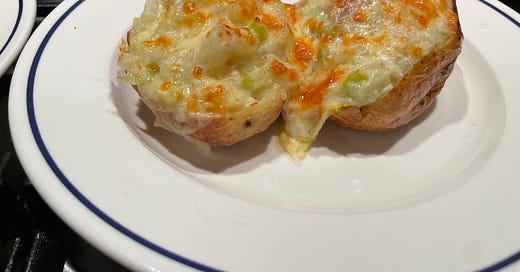


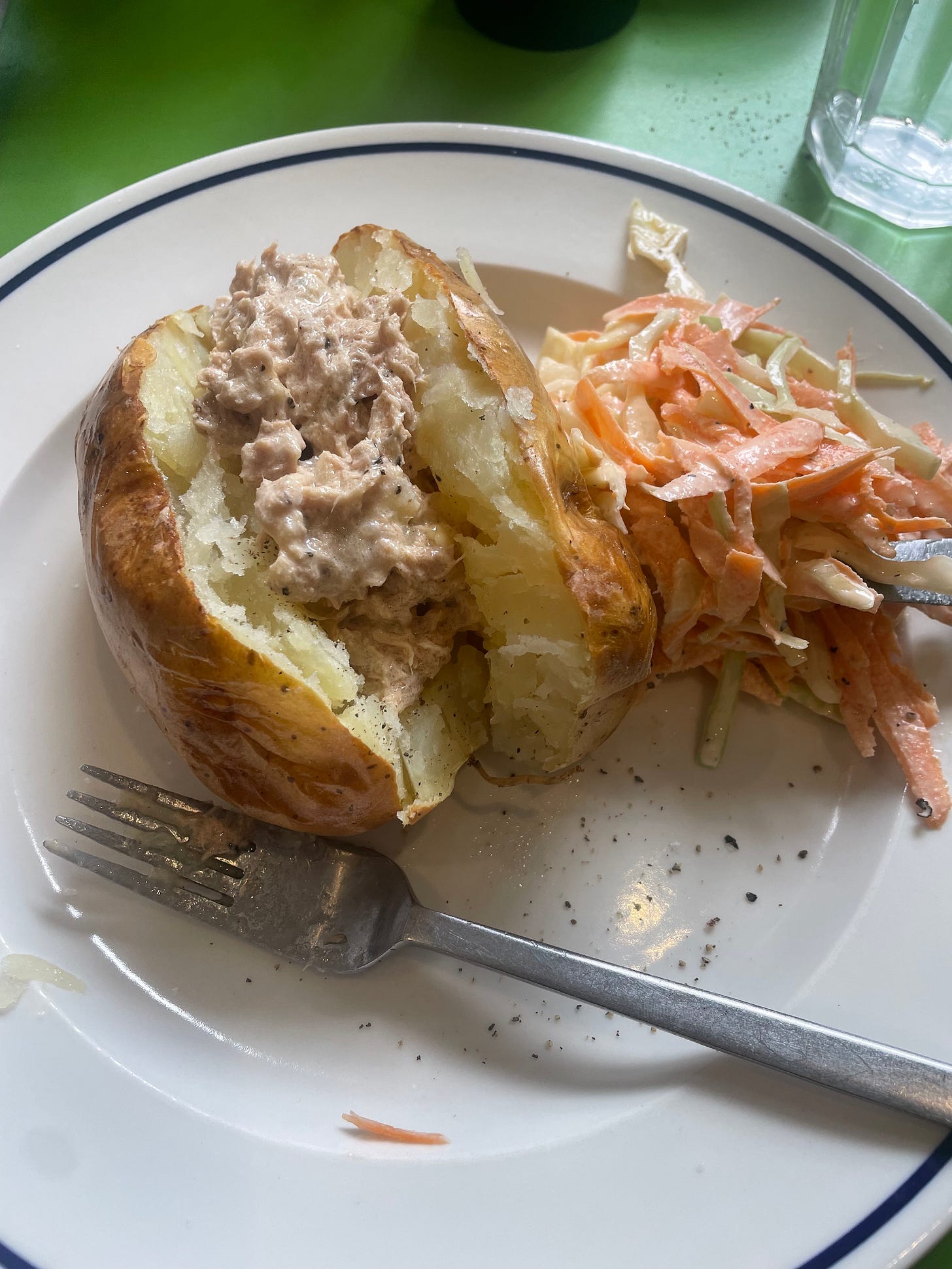


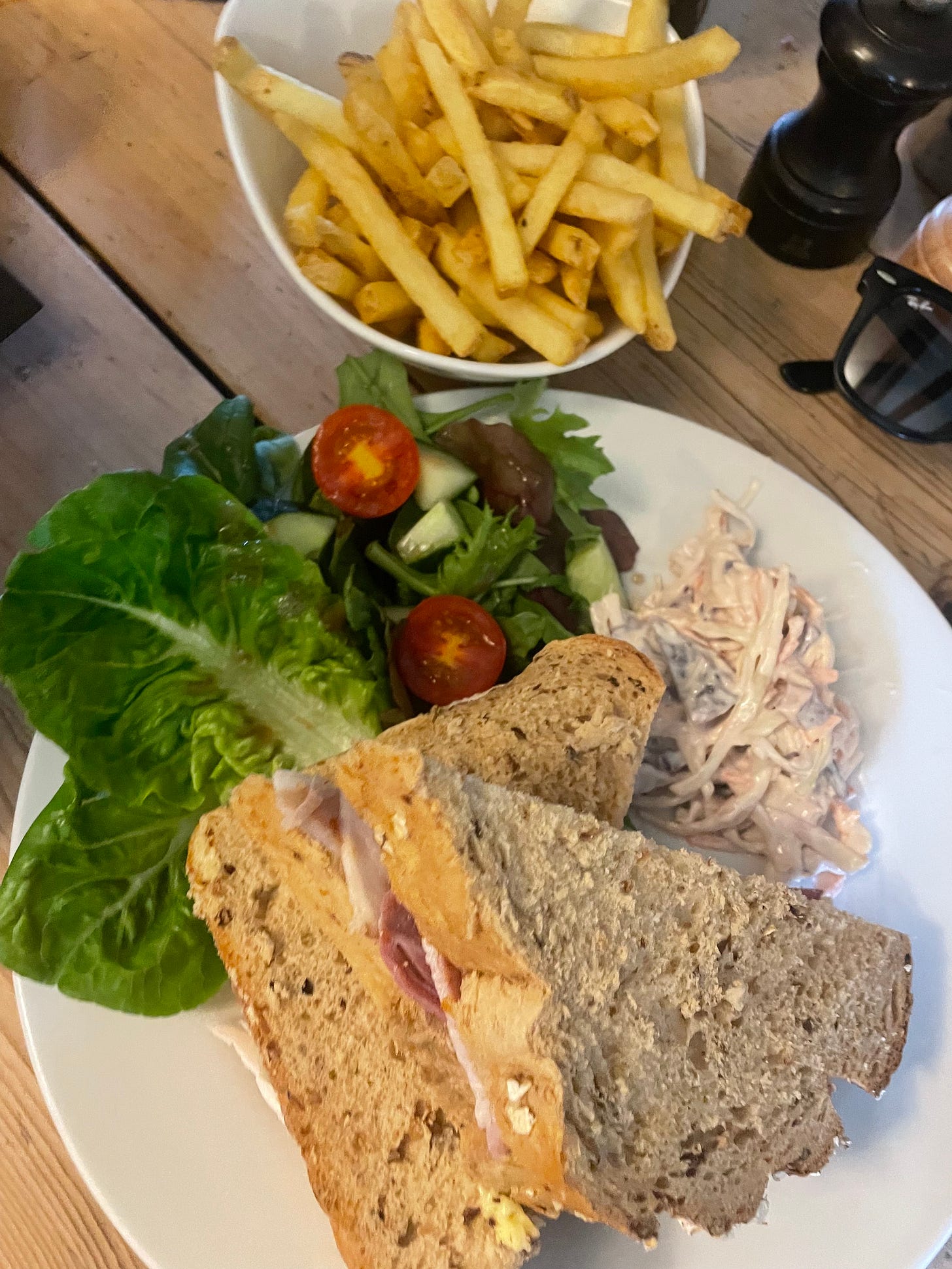
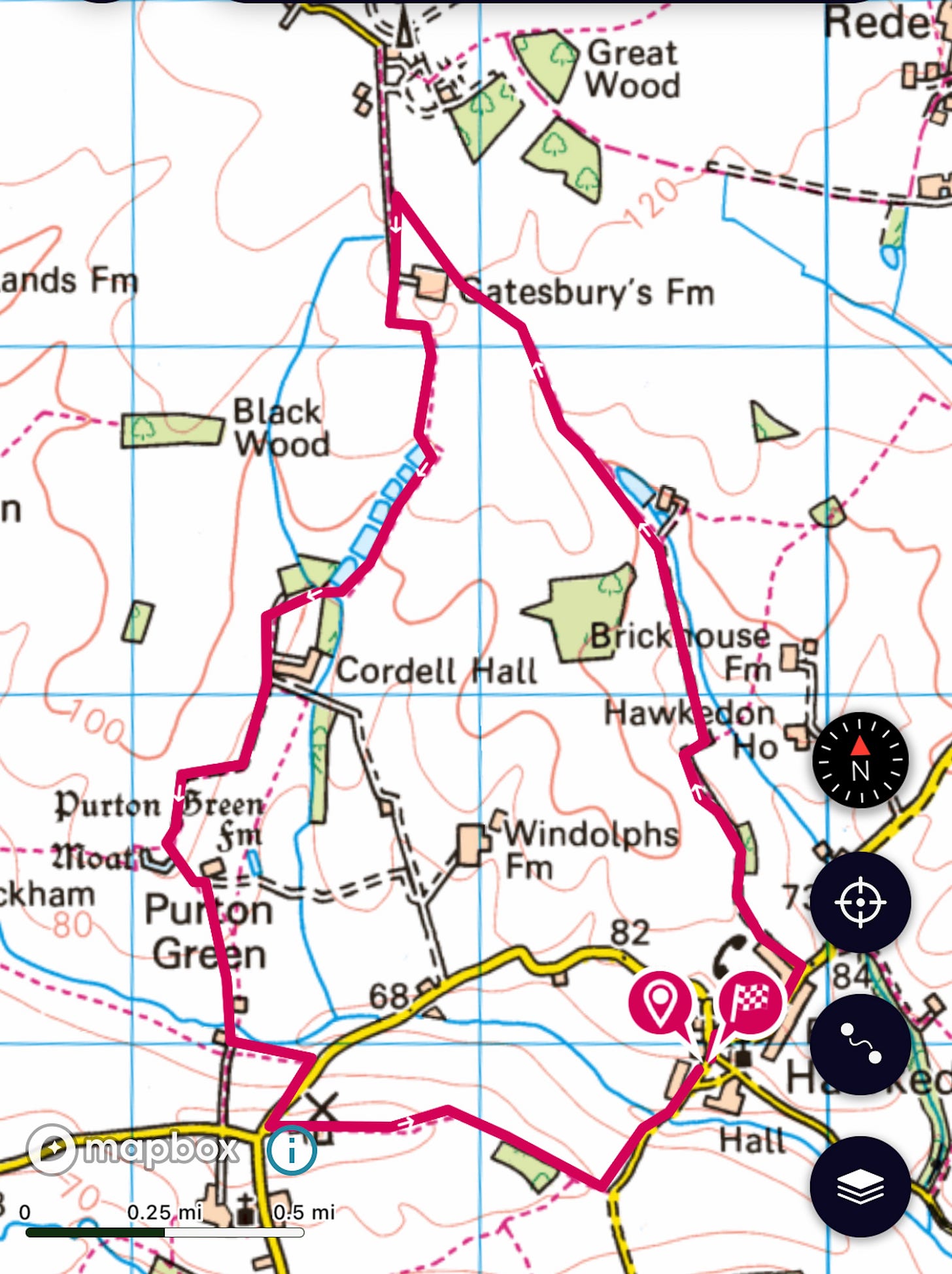
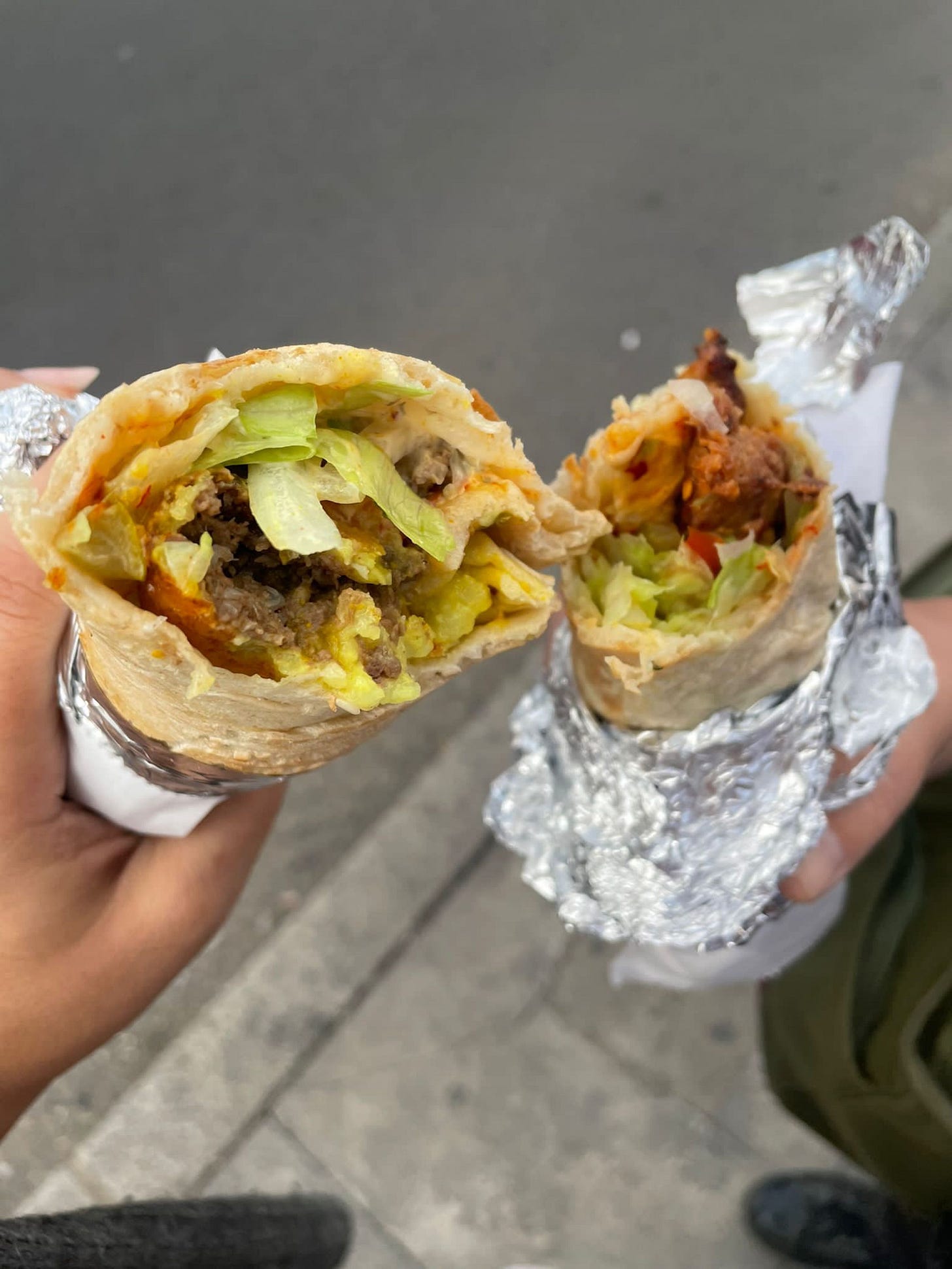
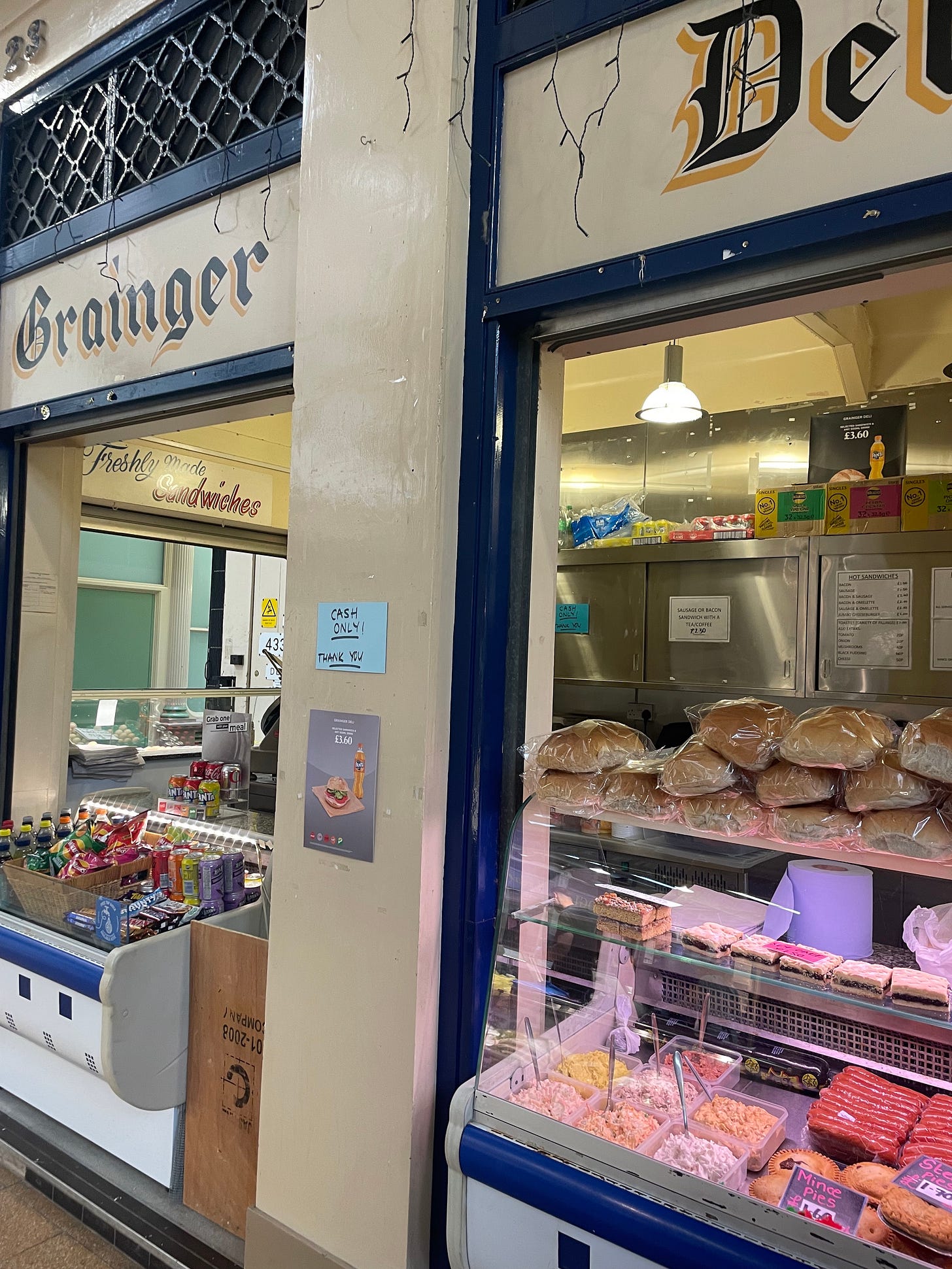

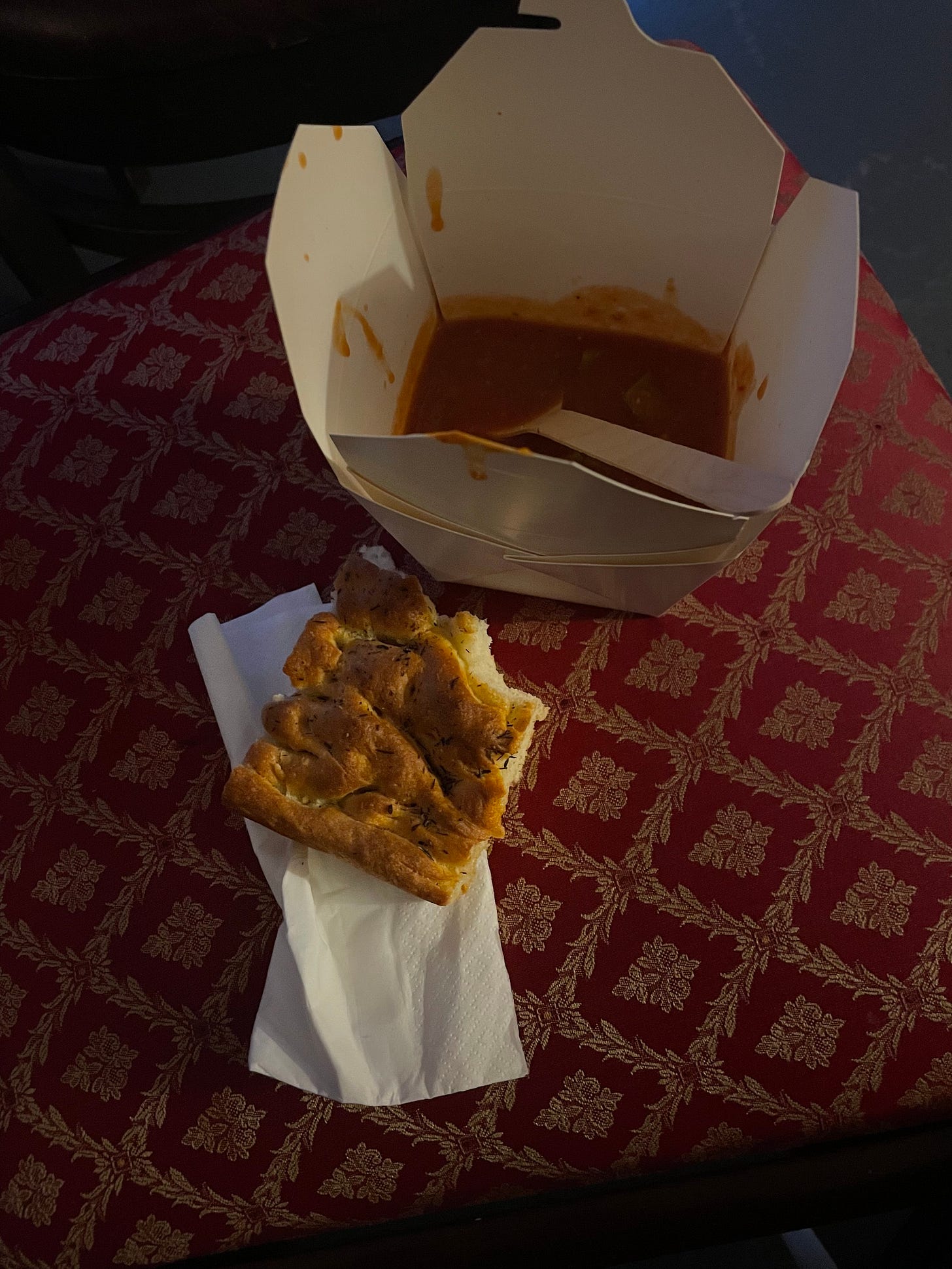
i love this so much. esp: "When we returned, chilled and wet, the house smelled of baking potatoes – earthy, toasted, a bit sweet", always excited by how you pull moments like these from life and freeze them. Also love you and Melek sitting on a bench eating wraps, wished i could've been there. thanks for this post!
I currently have a potato baking in the oven which will be topped with baked beans, 'extra mature' cheddar and Tabasco in about, ooh, twenty minutes. I used to buy those big tins of Glenryck pilchards (in brine) and mix the drained contents with mayonnaise for a potato topping. A treat I enjoy less nowadays due to the pilchard in brine being usurped on the supermarket shelves by the canned in tomato variety which is less appealing, especially if mixed with mayo. Rinsing helps.